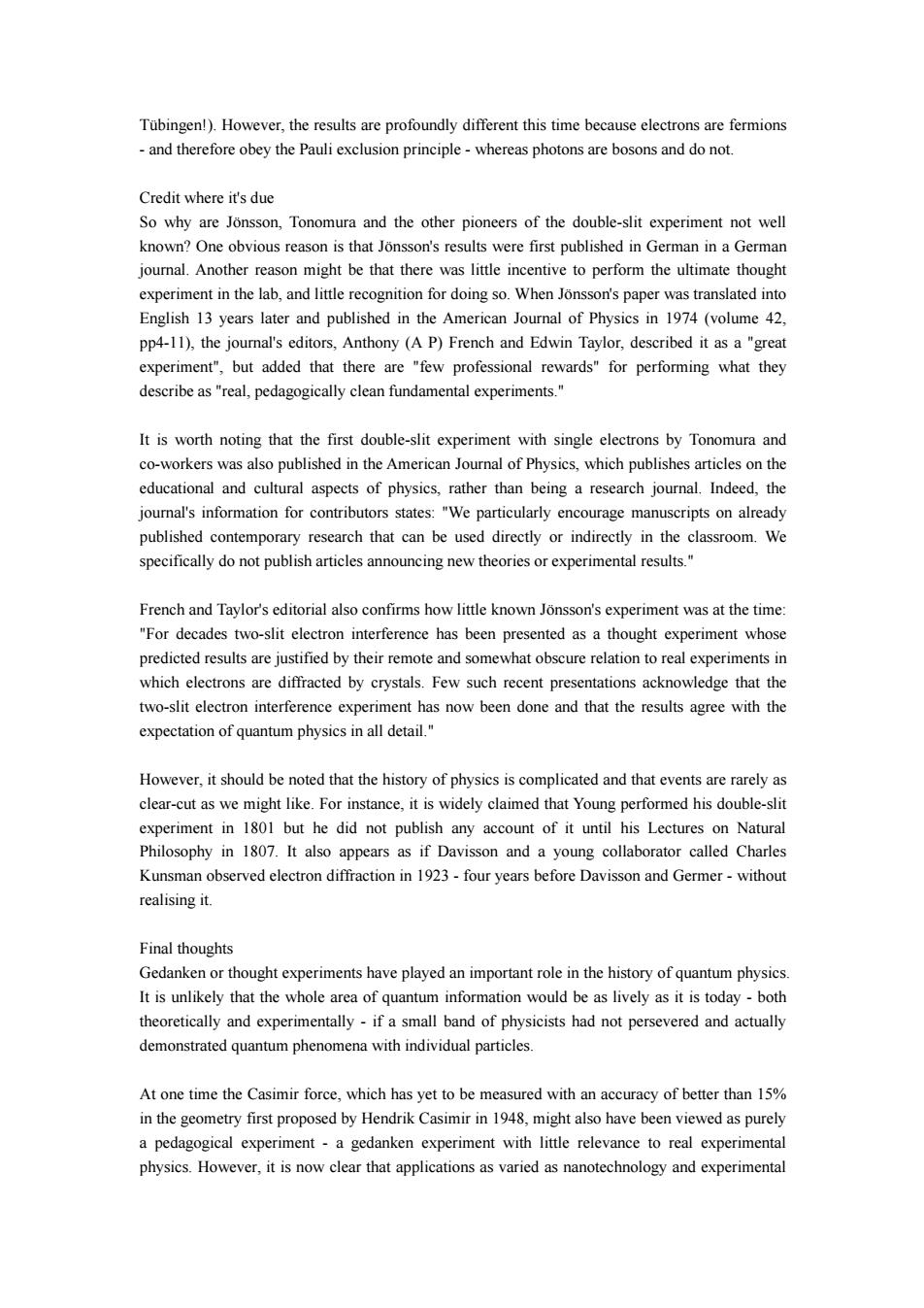正在加载图片...

Tubingen!).However,the results are profoundly different this time because electrons are fermions -and therefore obey the Pauli exclusion principle-whereas photons are bosons and do not. Credit where it's due So why are Jonsson,Tonomura and the other pioneers of the double-slit experiment not well known?One obvious reason is that Jonsson's results were first published in German in a German journal.Another reason might be that there was little incentive to perform the ultimate thought experiment in the lab,and little recognition for doing so.When Jonsson's paper was translated into English 13 years later and published in the American Journal of Physics in 1974(volume 42, pp4-11),the journal's editors,Anthony(A P)French and Edwin Taylor,described it as a "great experiment",but added that there are "few professional rewards"for performing what they describe as"real,pedagogically clean fundamental experiments." It is worth noting that the first double-slit experiment with single electrons by Tonomura and co-workers was also published in the American Journal of Physics,which publishes articles on the educational and cultural aspects of physics,rather than being a research journal.Indeed,the journal's information for contributors states:"We particularly encourage manuscripts on already published contemporary research that can be used directly or indirectly in the classroom.We specifically do not publish articles announcing new theories or experimental results." French and Taylor's editorial also confirms how little known Jonsson's experiment was at the time: "For decades two-slit electron interference has been presented as a thought experiment whose predicted results are justified by their remote and somewhat obscure relation to real experiments in which electrons are diffracted by crystals.Few such recent presentations acknowledge that the two-slit electron interference experiment has now been done and that the results agree with the expectation of quantum physics in all detail." However,it should be noted that the history of physics is complicated and that events are rarely as clear-cut as we might like.For instance,it is widely claimed that Young performed his double-slit experiment in 1801 but he did not publish any account of it until his Lectures on Natural Philosophy in 1807.It also appears as if Davisson and a young collaborator called Charles Kunsman observed electron diffraction in 1923-four years before Davisson and Germer-without realising it. Final thoughts Gedanken or thought experiments have played an important role in the history of quantum physics. It is unlikely that the whole area of quantum information would be as lively as it is today-both theoretically and experimentally-if a small band of physicists had not persevered and actually demonstrated quantum phenomena with individual particles. At one time the Casimir force,which has yet to be measured with an accuracy of better than 15% in the geometry first proposed by Hendrik Casimir in 1948,might also have been viewed as purely a pedagogical experiment-a gedanken experiment with little relevance to real experimental physics.However,it is now clear that applications as varied as nanotechnology and experimentalTübingen!). However, the results are profoundly different this time because electrons are fermions - and therefore obey the Pauli exclusion principle - whereas photons are bosons and do not. Credit where it's due So why are Jönsson, Tonomura and the other pioneers of the double-slit experiment not well known? One obvious reason is that Jönsson's results were first published in German in a German journal. Another reason might be that there was little incentive to perform the ultimate thought experiment in the lab, and little recognition for doing so. When Jönsson's paper was translated into English 13 years later and published in the American Journal of Physics in 1974 (volume 42, pp4-11), the journal's editors, Anthony (A P) French and Edwin Taylor, described it as a "great experiment", but added that there are "few professional rewards" for performing what they describe as "real, pedagogically clean fundamental experiments." It is worth noting that the first double-slit experiment with single electrons by Tonomura and co-workers was also published in the American Journal of Physics, which publishes articles on the educational and cultural aspects of physics, rather than being a research journal. Indeed, the journal's information for contributors states: "We particularly encourage manuscripts on already published contemporary research that can be used directly or indirectly in the classroom. We specifically do not publish articles announcing new theories or experimental results." French and Taylor's editorial also confirms how little known Jönsson's experiment was at the time: "For decades two-slit electron interference has been presented as a thought experiment whose predicted results are justified by their remote and somewhat obscure relation to real experiments in which electrons are diffracted by crystals. Few such recent presentations acknowledge that the two-slit electron interference experiment has now been done and that the results agree with the expectation of quantum physics in all detail." However, it should be noted that the history of physics is complicated and that events are rarely as clear-cut as we might like. For instance, it is widely claimed that Young performed his double-slit experiment in 1801 but he did not publish any account of it until his Lectures on Natural Philosophy in 1807. It also appears as if Davisson and a young collaborator called Charles Kunsman observed electron diffraction in 1923 - four years before Davisson and Germer - without realising it. Final thoughts Gedanken or thought experiments have played an important role in the history of quantum physics. It is unlikely that the whole area of quantum information would be as lively as it is today - both theoretically and experimentally - if a small band of physicists had not persevered and actually demonstrated quantum phenomena with individual particles. At one time the Casimir force, which has yet to be measured with an accuracy of better than 15% in the geometry first proposed by Hendrik Casimir in 1948, might also have been viewed as purely a pedagogical experiment - a gedanken experiment with little relevance to real experimental physics. However, it is now clear that applications as varied as nanotechnology and experimental